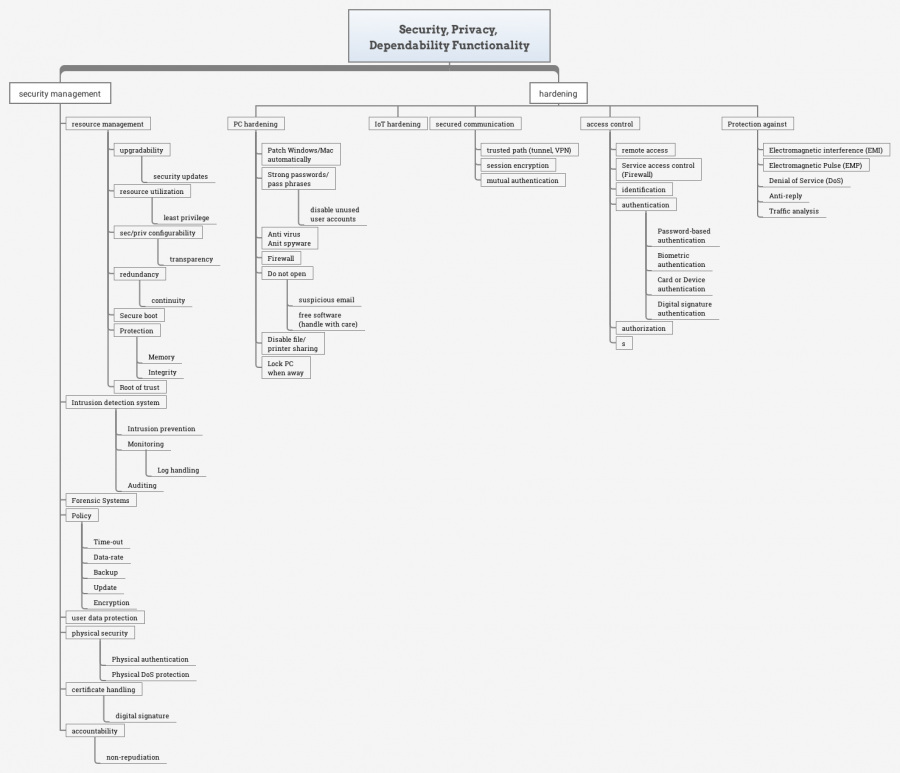Difference between revisions of "IoTSec:Security and Privacy Functionality"
From its-wiki.no
Josef.Noll (Talk | contribs) m (Josef.Noll moved page Security and Privacy Functionality to IoTSec:Security and Privacy Functionality without leaving a redirect) |
Josef.Noll (Talk | contribs) (→Security, Privacy and Dependability Functionality) |
||
| Line 8: | Line 8: | ||
Link: https://owncloud.unik.no/index.php/apps/files/ajax/download.php?dir=%2F1-Projects%2FIoTSec-IKTPluss&files=SPD-Functionality.xmind | Link: https://owncloud.unik.no/index.php/apps/files/ajax/download.php?dir=%2F1-Projects%2FIoTSec-IKTPluss&files=SPD-Functionality.xmind | ||
| − | + | == Security and Privacy Functionality paragraphs == | |
1. security management | 1. security management | ||
:1.1. Intrusion detection system | :1.1. Intrusion detection system | ||
| Line 46: | Line 46: | ||
::2.1.6. Disable file/ printer sharing | ::2.1.6. Disable file/ printer sharing | ||
::2.1.7. Lock PC when away | ::2.1.7. Lock PC when away | ||
| + | |||
:2.2. IoT hardening | :2.2. IoT hardening | ||
| Line 59: | Line 60: | ||
::3.4.1. Password-based authentication | ::3.4.1. Password-based authentication | ||
:: 3.4.2. Biometric authentication | :: 3.4.2. Biometric authentication | ||
| − | ::3.4.3. Card or Device | + | ::3.4.3. Card or Device authentication |
| − | authentication | + | ::3.4.4. Digital signature authentication |
| − | 3.4.4. Digital signature | + | :: 3.5. authorization |
| − | authentication | + | |
| − | 3.5. authorization | + | |
4. secured communication | 4. secured communication | ||
| + | :4.1. trusted path (tunnel, VPN) | ||
| + | :4.2. session encryption | ||
| + | :4.3. mutual authentication | ||
| − | + | 5. resource management | |
| − | + | :5.1. upgradability | |
| − | + | ::5.1.1. security updates | |
| − | 5. resource | + | :5.2. resource utilisation |
| − | + | ::5.2.1. least privilege | |
| − | 5.1. upgradability | + | :5.3. sec/priv configurability |
| − | + | ::5.3.1. transparency | |
| − | 5.1.1. security updates | + | :5.4. redundancy |
| − | 5.2. resource | + | :: 5.4.1. continuity |
| − | + | :5.5. Secure boot | |
| − | 5.2.1. least privilege | + | :5.6. Protection |
| − | 5.3. sec/priv configurability | + | ::5.6.1. Memory |
| − | + | ::5.6.2. Integrity | |
| − | 5.3.1. transparency | + | :5.7. Root of trust |
| − | 5.4. redundancy | + | :5.8. Protection against |
| − | + | ::5.8.1. Denial of Service (DoS) | |
| − | 5.4.1. continuity | + | ::5.8.2. Anti-reply |
| − | 5.5. Secure boot | + | ::5.8.3. Traffic analysis |
| − | 5.6. Protection | + | |
| − | + | ||
| − | 5.6.1. Memory | + | |
| − | 5.6.2. Integrity | + | |
| − | 5.7. Root of trust | + | |
| − | 5.8. Protection against | + | |
| − | + | ||
| − | 5.8.1. Denial of Service (DoS) | + | |
| − | 5.8.2. Anti-reply | + | |
| − | 5.8.3. Traffic analysis | + | |
Revision as of 08:42, 29 March 2017
| Security in IoT for Smart Grids | |||||||
|---|---|---|---|---|---|---|---|
|
Security, Privacy and Dependability Functionality
Keywords: Security, Privacy, Dependability, Security Functionality
The page is exported from see File:SPD Functionality.doc

Link: https://owncloud.unik.no/index.php/apps/files/ajax/download.php?dir=%2F1-Projects%2FIoTSec-IKTPluss&files=SPD-Functionality.xmind
Security and Privacy Functionality paragraphs
1. security management
- 1.1. Intrusion detection system
- 1.1.1. Intrusion prevention
- 1.1.2. Monitoring, Log handling
- 1.1.3. Auditing
- 1.2. Policy
- 1.2.1. Time-out
- 1.2.2. Data-rate
- 1.2.3. Backup
- 1.2.4. Update
- 1.2.5. Encryption
- 1.3. user data protection
- 1.4. physical security
- 1.4.1. Physical authentication
- 1.4.2. Physical DoS protection
- 1.5. certificate handling
- 1.5.1. digital signature
- 1.6. accountability
- 1.6.1. non-repudiation
2. hardening
- 2.1. PC hardening
- 2.1.1. Patch Windows/Mac automatically
- 2.1.2. Strong passwords/ pass phrases
- disable unused
- user accounts
- 2.1.3. Anti virus/Anit spyware
- 2.1.4. Firewall
- 2.1.5. Do not open
- suspicious email
- free software (handle with care)
- 2.1.6. Disable file/ printer sharing
- 2.1.7. Lock PC when away
- 2.2. IoT hardening
- 2.3. Protection against
- 2.3.1. Electromagnetic interference (EMI)
- 2.3.2. Electromagnetic Pulse (EMP)
3. access control
- 3.1. remote access
- 3.2. Service access control (Firewall)
- 3.3. identification
- 3.4. authentication
- 3.4.1. Password-based authentication
- 3.4.2. Biometric authentication
- 3.4.3. Card or Device authentication
- 3.4.4. Digital signature authentication
- 3.5. authorization
4. secured communication
- 4.1. trusted path (tunnel, VPN)
- 4.2. session encryption
- 4.3. mutual authentication
5. resource management
- 5.1. upgradability
- 5.1.1. security updates
- 5.2. resource utilisation
- 5.2.1. least privilege
- 5.3. sec/priv configurability
- 5.3.1. transparency
- 5.4. redundancy
- 5.4.1. continuity
- 5.5. Secure boot
- 5.6. Protection
- 5.6.1. Memory
- 5.6.2. Integrity
- 5.7. Root of trust
- 5.8. Protection against
- 5.8.1. Denial of Service (DoS)
- 5.8.2. Anti-reply
- 5.8.3. Traffic analysis
